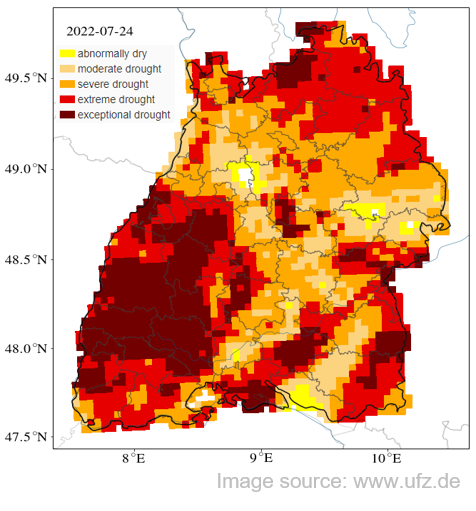Potential and feasibility study on the extension of the use of dams in Baden-Württemberg for the real-time management of heat, drought and floods (HDH-BaWü)
- contact:
Project Description
Project Summary
Floods and droughts seem to be dichotomous hydrological events: floods are rapid and short-lived, while droughts are slower but longer; flood protection requires empty reservoirs, while drought protection requires full ones. Reservoirs—particularly small and medium-sized retention basins—have thus far been built and operated in Germany primarily for flood protection. The increase in frequency and intensity of drought and heat waves in Germany during the recent decades suggests an expanded usage of these reservoirs. Thus, the ability of reservoirs for simultaneous flood, heat, and drought protection should be investigated. Structural, legal, economic, ecological, and in particular operational aspects are considered in a risk-based cost-benefit analysis for existing reservoirs in Baden-Württemberg. This project, a potential study for the expanded usage of flood reservoirs for heat and drought protection in Baden-Württemberg (HDH-BaWü), is executed in cooperation with partners in local administration (Landesanstalt für Umwelt Baden-Württemberg LUBW), industry (WALD+CORBE), and academia (Theodor-Rehbock-Laboratory for River Improvement at KIT).
Background and Preliminary Work
In Baden-Württemberg, there currently exists over 600 reservoirs and dams, the vast majority of which (91%) stand primarily for flood protection. Of these, only 182 are permanently inundated, while the others stand empty during the dry season (LUBW, 2008). This is a reflection of the historical situation in the region: the excess of water—in other words, floods—has thus far been the greatest water-related risk. However, as devastating droughts and heat waves have swept across Central Europe and particularly southern Germany (2003, 2018, 2020; Erfurt et al., 2020), risk of future water shortages have entered public conversation. This has been especially relevant with the progression of climate change, fueling an increase in frequency and intensity of such events (KLIWA, 2012; IPCC, 2018; Samaniego et al., 2018). Heat waves and droughts are costly and devastating to many sectors of public life, including drinking water supply, hydropower, river ecology, forestry, and agriculture (Blauhut and Stahl, 2018). Thus the question emerges: can these preexisting reservoirs be retrofitted and adapted to not only protect against flood but also against drought?
Initial steps towards this goal are currently being taken in Baden-Württemberg. For example, the flood reservoir Beimbach is currently under renovation for additional low-flow supplementation capability. However, there is a need for scientific research regarding the compatibility of these seemingly dichotomous protection strategies, their quantifiable and achievable benefit, and potential adverse consequences. Another major question is if currently existing meteorological and hydrological warning systems can be successfully integrated into a dual-use reservoir operation scheme to balance the user conflicts between storing water for floods and releasing water for droughts.
Project Goals
The overarching goal of the project is to determine if pre-existing reservoirs can also be used for heat and drought protection without significantly compromising their flood retention capability. Heat and drought protection secures water not only for drinking and public use, but also for hydropower production, ecological protection, agriculture, forestry, and groundwater aquifer replenishment.
This project will be implemented in Baden-Württemberg as an example and encompasses the following additional questions:
- What is the current maximum benefit of the existing reservoirs in a completely heat/drought-optimized reservoir operation system when all other criteria (e.g. required ecological flows, industry usage) are ignored?
- What are the costs and benefits of the current operation system (i.e. purely flood-optimized)?
- What are the costs and benefits of a combined heat/drought/flood operation system that minimizes ecological and agricultural disruption from longer or more frequent storage?
- Is there a combined heat/drought/flood operation system that is not only i) practical, but also ii) is overall more beneficial than a single-use system?
- Would a heat/drought operation system require a yearlong management plan, or is a seasonal (or possibly even shorter-term) plan sufficient?
- To what extent and with how much certainty can hydro-meteorological forecasts (1-2 days) improve the combined usage? A particular concern will be if a filled reservoir can be successfully emptied before a flood.

Fig.: Drought conditions in soil moisture in summer of 2022 (Source: Dürremonitor/UFZ).
References:
- Blauhut, V., & Stahl, K. (2018). Risikomanagement von Dürren in Deutschland: von der Messung von Auswirkungen zur Modellierung. Forum Hydrol. und Wasserbewirts, 28, 203-213.
- Erfurt, M., Skiadaresis, G., Tijdeman, E., Blauhut, V., Bauhus, J., Glaser, R., et al. (2020). A multidisciplinary drought catalogue for southwestern Germany dating back to 1801. Natural Hazards and Earth System Sciences, 20(11), 2979-2995.
- KLIWA. (2012). Die Entwicklung von trockenen Großwetterlagen mit Auswirkungen auf den süddeutschen Raum. KLIWA-Berichte, 18.
- LUBW. (2008). Hochwasserrückhaltebecken und Talsperren: Bauwerkstypen und Übersicht. Oberirdische Gewässer, Gewässerökologie, 111. Broschure.
- Masson-Delmotte, V., Zhai, P., Pörtner, H. O., Roberts, D., Skea, J., Shukla, P. R., et al. (2018). Global warming of 1.5°C. Retrieved from
- Samaniego, L., Thober, S., Kumar, R., Wanders, N., Rakovec, O., Pan, M., et al. (2018). Anthropogenic warming exacerbates European soil moisture droughts. Nature Climate Change, 8(5), 421-426.

